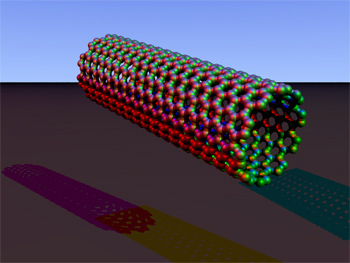July 28, 2008
Killing Cancer Cells–Selectively–With Carbon Nanotubes

By Michael D. Shaw
Critics of conventional cancer therapy identify the three main treatment modalities thus: slashing (surgical removal of affected tissue), burning (radiation), and poisoning (chemotherapy). While these descriptions might be extreme, they do point out that traditional methods damage a goodly number of healthy cells, along with the cancerous ones. The holy grail of cancer therapy is to selectively attack the tumor cells, and not affect surrounding healthy tissue.
Recent research coming out of the University of Texas, presented in a paper entitled “Thermal ablation of tumor cells with antibody-functionalized single-walled carbon nanotubes,” and published in Proceedings of the National Academy of Sciences, suggests that we could be closer to that goal.
A carbon nanotube is a long cylindrical arrangement of carbon atoms, that can be thought of as a sheet of graphite rolled into a cylinder. Perhaps the most studied tubes are the single-walled carbon nanotubes (SWNT). An SWNT can be likened to a nano-sized piece of chicken wire, whereby each “cell” is formed of a hexagonal ring of carbon atoms. One of the many interesting properties of SWNTs is that they emit heat when exposed to near-infrared light.
The most common application of near-infrared is to enable TV remote controls to do their thing. Near-infrared can also penetrate human tissue to a depth of about 1½ inches (3.8 cm).
In this study, cultures of lymphoma cells were utilized. Nanotubes were coated with monoclonal antibodies, that targeted specific sites on the cells. A monoclonal antibody is the real-life embodiment of the magic bullet proposed by Nobel prize winner Paul Ehrlich in the early 1900s. The idea is that should it be possible to create some compound which selectively targeted a certain pathogen, then a toxin for that organism could be delivered—along with the agent of selectivity. As such, this “magic bullet” would kill only the targeted organism.
As it happened in this experiment, the antibody-coated nanotubes did attach to the surface of the lymphoma cells. Upon exposure to the near-infrared light, the tubes heated up and killed the cells. In a control group with nanotubes coated with a different antibody, binding did not occur, and the tumor cells were left unharmed.
Listen to Dr. Ellen Vitetta, director of the Cancer Immunobiology Center at UT Southwestern and senior author of the study:
“Using near-infrared light for the induction of hyperthermia is particularly attractive because living tissues do not strongly absorb radiation in this range. Once the carbon nanotubes have bound to the tumor cells, an external source of near-infrared light can be used to safely penetrate normal tissues and kill the tumor cells.
Demonstrating this specific killing was the objective of this study. We have worked with targeted therapies for many years, and even when this degree of specificity can be demonstrated in a laboratory dish, there are many hurdles to translating these new therapies into clinical studies. We’re just beginning to test this in mice, and although there is no guarantee it will work, we are optimistic.”
Of course, one problem that needs to be addressed is the matter of how nanomaterial introduced in vivo could harm the recipient. In other words, what are the side effects of nanotherapy, and how can they be minimized or even eliminated?
Dr. Rockford Draper, another of the lead scientists on the project answers that, “There are rational approaches to detecting and minimizing the potential for nonspecific toxicity of the nanoparticles developed in our studies.”
That sounds promising, but also indicates that much work still remains. The good news is that nanotubes also show promise against a variety of pathogens such as E. coli and B. anthracis. In this era of emerging antibiotic resistant infections, consider it excellent timing.
How long it will take before nanotherapy is actually practical is anybody’s guess. Still, the spirit of Paul Ehrlich must be smiling.

